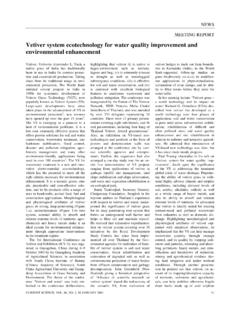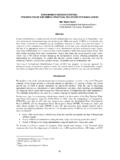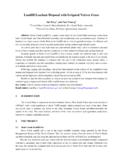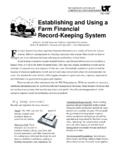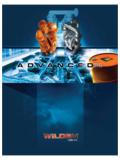Transcription of The Use of Vetiver Grass Wetlands for Sewerage Treatment ...
1 132 The Use of Vetiver Grass Wetlands for Sewerage Treatment in AustraliaRalph Ash1, and Paul Truong21 Utilities Engineer, Esk Shire Council, Esk, Queensland, Australia2 Veticon Consulting, Brisbane, Queensland, AustraliaAbstract: The Esk Shire Council has recently installed a Vetiver Grass Wetlands System to treatsewerage effluent at Toogoolawah in South East Queensland. The Sewerage Treatment plant is situated ona 22-ha site on the northern edge of aim of this scheme was to improve water quality before the effluent discharges to the naturalwetlands.
2 The biggest problem with the quality of the effluent is its high nutrient loading. With the recentchanges to license conditions imposed by the Environmental Protection Agency, the existing treatmentplant no longer complies with the license and an upgrade of the plant was of traditional upgrades, a new and innovative phyto-remedial technology recentlydeveloped in Queensland by the Department of Natural Resources and Mines, is being implemented atToogoolawah. Under the Vetiver Wetlands System, the effluent is being treated in two stages: Preliminary Treatment of the pond effluent in situ by floating pontoons placed in the ponds, andby Vetiver planting around the edges of the three Sewerage ponds.
3 Main Treatment by Vetiver Wetlands , once the effluent exits the Sewerage ponds it passesthrough a Vetiver Grass contoured Wetlands constructed over 3 hectares of the land. TheVetiver Grass Wetlands have been constructed in rows following the contours to allow goodcontact between the Grass and the effluent. The Vetiver Grass takes up the water and inparticular the Grass will remove the nutrients from the water that passes through Vetiver Grass system is very effective in removing nutrient loads, it is expected that once thewetlands is properly established there should be no release of Sewerage effluent from the Treatment plantexcept in times of heavy scheme will provide a large-scale prototype of possible Sewerage Treatment schemes that canbe used throughout western Queensland and other locations where there is plenty of land and where thelocal government doesn t want to pay for installing and operating high cost words: Vetiver Grass , Sewerage , effluent, Wetlands , Sewerage ponds, nutrient contact.
4 Ralph Ash or Paul Truong Esk ShireThe Esk Shire is situated on the northwestern edge of Brisbane and covers an area of 3946 the population of the shire is only about 14,800 people and this is scattered over most of theshire. The shire is 125 km long (running north/south) and 70 kilometres wide. There are several smalltowns in the shire and these are difficult to service with town water as they are also scattered up and downthe ToogoolawahThe town of Toogoolawah is situated right in the centre of the shire. The town has a population ofapproximately 1,000 persons and provides the local people with a quiet rural lifestyle close to the largeCapital City of Brisbane (2 million population).
5 1332 THE Toogoolawah Sewerage PlantThe Sewerage scheme for Toogoolawah was built in 1970 and the Treatment plant was constructedas a primary sedimentation (Imhoff Tank) followed by three Sewerage ponds. The effluent from the pondswas designed to flow down into a swamp area before it overflowed into the local creek. The plantconstruction was based on a very simple design but it is effective. With the recent changes to licenseconditions imposed by the Environmental Protection Agency (EPA) the plant no longer complies with thelicense and so an upgrade of the plant was required.
6 Various options were considered such as a nutrientremoval plant, a sand filter or a rock filter. These are expensive options and would require expensiveongoing operational costs. Council then considered a Vetiver Grass Wetlands system that would take upmost of the water, as well as remove nutrients and heavy metals etc. from the Sewerage effluent. Therequired land had already been purchased and so there was ample room for the Vetiver Grass License LimitThe main problem with the existing Sewerage effluent was that while passing through the threeponds the nutrients were providing an environment for the production of high concentrations of in turn made the pH rise from up or higher, the license limit is Also the suspended solidcounts did not improve (about 85 mg/L) due mainly to the algae counts.
7 The suspended solid license limitis 30 mg/L. The BOD reading does improve through the ponds reducing from 120 mg/L to 29 mg/L. Thisis close to the license limit of 20 mg/L. The high suspended solids counts are also a cause of high FaecalColiform counts that occur once or twice a year. Reading over 6000 organisms per 100 ml are recordedwhile the license limit is 1000 organisms per 100 Vetiver IntroductionApplication of the Vetiver System (VS) for wastewater Treatment is a new and innovativephytoremedial technology recently developed in Queensland by the Department of Natural Resources andMines, NRM, (Truong and Hart, 2001).
8 It is a green and environmentally friendly wastewater treatmenttechnology as well as a natural recycling method. Its end-product has several uses including animalfodder and material for organic Vetiver GrassVS is based on the use of Vetiver Grass (Vetiveria zizanioides (L.) Nash), which was firstrecognised early in the 1990s for having a super absorbent characteristics suitable for the Treatment ofwastewater and leachate generated from landfill in Queensland (Truong and Stone, 1996). Researchconducted by NRM showed that Monto Vetiver Grass has a fast and very high capacity for absorption ofnutrients, particularly nitrogen and phosphorus in wastewater.
9 In addition it has a very high water use rateand tolerant to elevated levels of agrochemicals and heavy metals in the effluent (Cull et al., 2000;Truong and Baker, 1998). As a result of these findings, presently VS has been used successfully for thesepurposes in Australia, China, Thailand, Vietnam and Senegal (Truong and Hart, 2001; Truong, 2000). Effectiveness of Vetiver GrassA Vetiver Grass system is much more efficient in treating wastewater than other grasses currently134used for this purpose in Queensland. For example, at an abattoir near Brisbane, MEDLI model (Model forEffluent Disposal by Land Irrigation) predicted that to sustainably dispose of 2 ml of effluent (155 mg/Lof N and 15 mg/L of P) per day, the abattoir would need 178 ha of land if Kikuyu Grass was used, butonly ha would be needed when Vetiver Grass was used.
10 This land area could be further reduced if theeffluent was treated with VS first before Australian Research ResultsA demonstration site was set up at the Beelarong Community Farm at Morningside, Brisbane toobtain quantitative data on the effect of VS in improving its quality under field conditions and also inreducing the volume of effluent. In this NRM and EPA funded project, VS was used to treat the dischargefrom a septic system. Vetiver Grass was selected after the failure of other plants including a variety of fastgrowing tropical grasses and trees, and crops such as sugar cane and banana to absorb the effluentdischarge from the septic tank.
